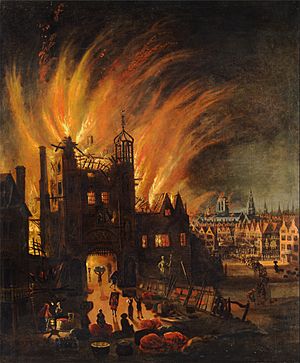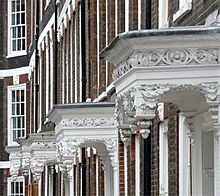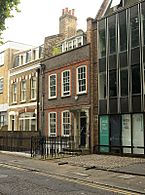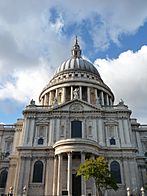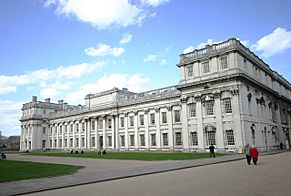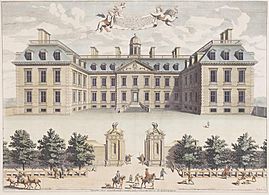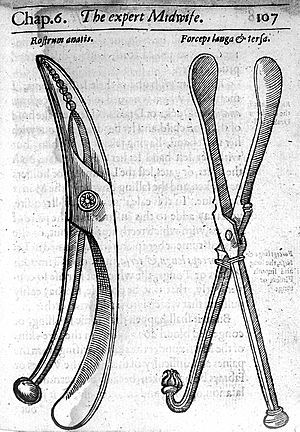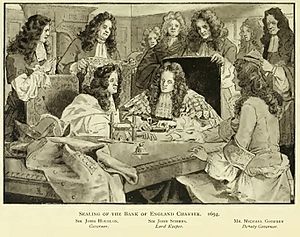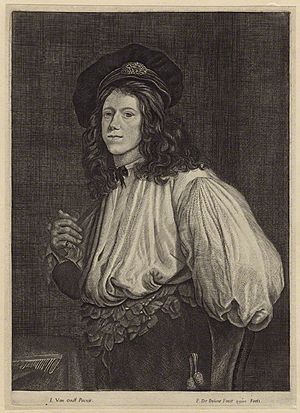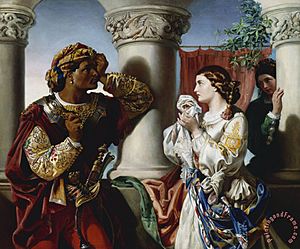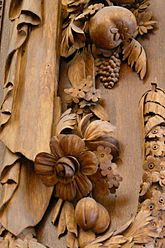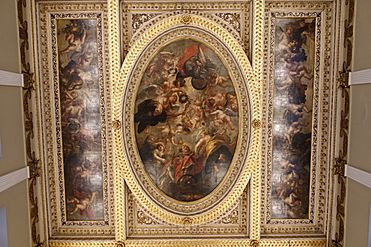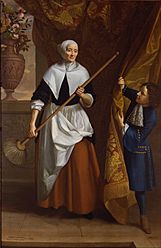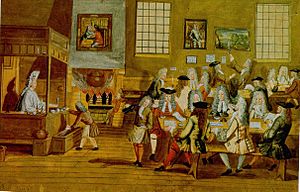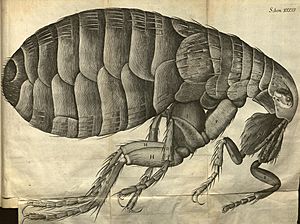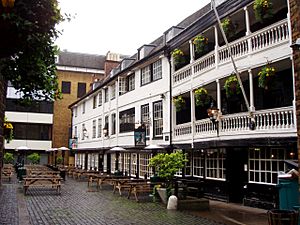Stuart London facts for kids
| 1603–1714 | |
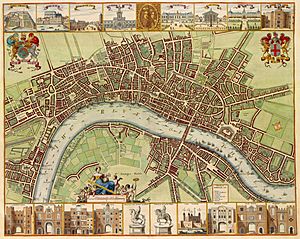
Map of London c.1690, after Wenceslaus Hollar
|
|
| Preceded by | Tudor London |
|---|---|
| Followed by | 18th-century London |
| Monarch | James VI and I, Charles I of England, Charles II of England, James II of England, William III of England and Mary II of England, Queen Anne |
| Leader(s) | Oliver Cromwell, Richard Cromwell |
The Stuart period in London started when James VI and I became king in 1603. It ended when Queen Anne died in 1714. During this time, London faced big challenges. These included the English Civil War, the terrible Great Plague of London, and the huge Great Fire of London.
Contents
London's Growing Population
London grew a lot during the Stuart period. In 1600, about 200,000 people lived there. By 1650, this number grew to 375,000. By 1700, London had 575,000 people. This made it by far the biggest city in England. Its population was more than four times larger than the next ten biggest English cities combined.
Many people from other countries also lived in London. In 1639, about 1,688 foreigners lived in Westminster and the City. Most were from France and the Netherlands. There were also people from Belgium, Italy, Spain, Germany, and Poland.
Jewish and Huguenot Communities
At the start of this period, Jewish people were not officially allowed to live in England. However, a small number of Jewish families were already in London. In 1656, Oliver Cromwell, who led England at the time, said he would no longer stop Jewish people from returning. They built their first synagogue in 1657. The Bevis Marks Synagogue was built later, between 1700 and 1701. By 1660, about 35 Jewish families, mostly from Poland and Germany, lived in the East End.
After 1685, thousands of French Protestants, called Huguenots, came to Britain. Many settled in London, especially in an area called Spitalfields. By 1697, London had 22 French Protestant churches. Other groups, like the Dutch, Italians, and Danes, also built their own churches. Thanks to these new communities, the East End's population grew a lot. It went from 21,000 people in 1600 to 91,000 in 1700.

Black People in London
There were also some black people living in London during this time. Many were enslaved people who worked in the homes of wealthy people. Others were freed servants. King Charles II had a black pageboy. In 1662, Lord Sandwich bought "a little Turk and a negro" for his daughters. The writer Samuel Pepys had a black kitchen maid. A naval officer named William Batten had a black manservant called Mingo.
Visitors from Far Away
London also welcomed visitors from distant lands. In 1616, Pocahontas, a Native American woman, arrived from Virginia with her son, Thomas Rolfe. In 1682, two ambassadors from Banten in Indonesia, Kyayi Ngabehi Naya Wipraja and Kyayi Ngabehi Jaya Seidana, also visited London.
London's Look and Buildings
In the Stuart period, the City of London was still surrounded by its old Roman city wall on three sides. The river Thames formed the fourth side to the south. But London grew far beyond these walls. It stretched to Wapping in the east and Westminster in the west. Places like Shoreditch and Clerkenwell, which used to be separate, became part of London as it expanded.
Most ordinary houses were made of wood. Each floor often stuck out further than the one below it. This meant that in some narrow streets, the houses almost touched across the road. After 1662, houses on main roads had to have lanterns burning outside until 9 p.m. This was an early form of street lighting. Many famous landmarks in Stuart London were built before this period. These included the Tower of London, the Royal Exchange, and London Bridge.
Buildings Damaged or Destroyed
Some of London's buildings were badly damaged during the English Civil War. For example, St. Paul's Cathedral was already in poor condition. In 1648, soldiers used it as a stable. They broke stained glass, burned pews for firewood, and even baptized a foal in the church's font.
On Sunday, September 2, 1666, the Great Fire of London began. It started at 1 a.m. in a house on Pudding Lane. A strong wind helped the fire spread quickly. The wooden houses with thatched roofs were very dry after a hot summer. The fire burned for several days. It destroyed about 60% of the City. This included Old St Paul's Cathedral, 87 churches, and the Royal Exchange. About 13,200 houses were destroyed, leaving 100,000 people homeless. Large camps for these people formed outside the City. The official death toll was very low, only 4 people, but many believed the real number was much higher. The fire caused huge financial losses across the country.
The Great Fire was the most famous, but London had other big fires too. Fires destroyed buildings like Hungerford House in 1669 and the Theatre Royal in 1672. In 1676, 624 properties in Southwark burned down. The Palace of Whitehall also suffered a fire in 1698. Big storms in 1662, 1678, and 1690 also caused damage to buildings.

New Buildings and Rebuilding
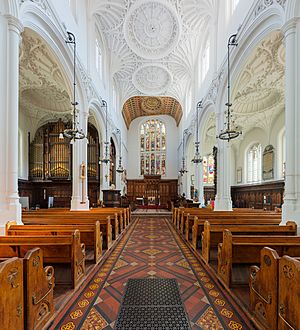
London's first new church since 1550 was the Queen's Chapel. It was built in the 1620s and designed by Inigo Jones. Jones was a very important architect. He built other key buildings like the Queen's House in Greenwich and Banqueting House in Whitehall Palace. Jones brought a new style of architecture to London, inspired by Italian designs. Architects in London started to use a classical style instead of the older Gothic architecture. However, some Gothic churches were still built, like St Mary Aldermary (around 1629). Later, new churches were built to keep up with London's growing population. These included St Anne's Limehouse and St Paul's, Deptford.
During the English Civil War, Parliament's army built forts around London. These were to protect the city from attacks. Earth walls were built in a ring around the City.

This period saw the first major growth of what is now called London's West End. Rich people and developers bought farmland and built houses there. They hoped to make money by renting them out. These new houses were usually made of brick or stone, not wood. A famous example is Covent Garden. The Earl of Bedford asked Inigo Jones to turn fields into a square of fancy townhouses around a market. This design became a model for future developments. St James's Square was built in 1665. Large mansions like Burlington House were built along Piccadilly. Later, Leicester Square, Soho Square, and Golden Square were built in the 1670s. Downing Street was built in 1682.
The area called Bloomsbury also began to be built up. Southampton Square was built in 1660. Red Lion Square was built in the 1680s. Other streets like George Street and Villiers Street were also developed.
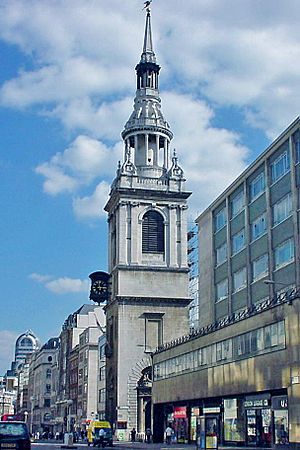
The East End also grew, but with houses for working-class families. Hoxton Square was built in the 1680s. The fields around St. Mary Spital church became Spitalfields, especially after many French Huguenots moved there. A market was also set up in Spital Square in 1682.
A lot of rebuilding happened after the Great Fire of London in 1666. St Paul's Cathedral was rebuilt by the famous architect Christopher Wren between 1670 and 1711. He also rebuilt 51 other churches in the City. After the fire, new laws made sure that houses were built with stone or brick, not wood. The Monument to the Fire was finished in 1676.
Other important new buildings included Eltham Lodge (1663) and Kensington Palace, which started in 1689 for King William III. The old Greenwich Palace was turned into the Greenwich Hospital, London in 1694. This was a place where retired or injured sailors could live. A similar place for soldiers, the Royal Hospital Chelsea, began in 1682.
War and Conflict
In 1642, fighting broke out between King Charles I and his Parliament. This started the English Civil War. Royalist forces marched towards London. They took Syon House and attacked Parliament's boats on the Thames. In November 1642, Prince Rupert's Royalist troops looted Brentford. But they could not get closer to London. Parliament captured the king, and he was held at Hampton Court Palace for several months in 1647.
Woolwich became a military base in 1671. It was used to store weapons and test new armaments.
Health and Medicine
In years without the plague, the biggest cause of death in London was tuberculosis. It caused about 18% of all deaths between the 1660s and 1690s. Other common causes of death included "fits," "ague and fever" (which included malaria), dysentery, smallpox, and measles.
Major outbreaks of the plague happened in 1603, 1625, and most famously, in 1665. This last one is known as the Great Plague of London. Officially, 68,596 people died, which was about 15% of London's population. However, many people at the time thought the real number was much higher. Modern estimates suggest over 100,000 deaths, or more than a quarter of London's total population.
London had two main hospitals: St. Bartholomew's and St. Thomas'. There were also hospitals for people with mental illness. The most famous was St. Mary of Bethlehem, also known as Bedlam. People could visit Bedlam's patients if they made a donation.
During this period, the Chamberlen family of midwives developed the use of forceps for difficult births. Before this, babies who could not be born naturally often did not survive. The Chamberlens' method offered a chance to save both the baby and the mother. They kept their invention a secret for a long time.
The most respected doctors were the Fellows of the Royal College of Physicians. They were based in London and could be hired for high fees. Thomas Sydenham was a very famous physician. He was known for his success in treating patients.
Religion
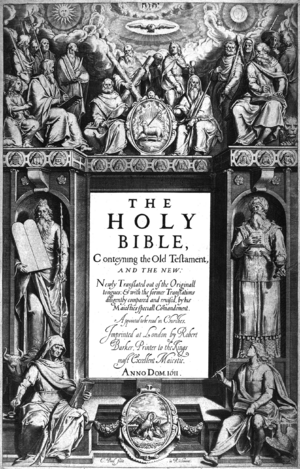
The King James Bible was published in 1611.
Religion was very important in Stuart London. The type of Christianity you followed could even be a matter of life or death. There was strong anti-Catholic feeling. In 1662, the Act of Uniformity made everyone worship according to the Church of England's prayer book. King Charles II tried to allow more religious freedom in 1672, but this was stopped because of anti-Catholic feelings. Still, non-Church of England Protestants were allowed to worship in special buildings, and Catholics could worship in private.
The Quaker movement started in the 1640s. But Quakers were often treated badly by law and society. Meetings of five or more Quakers were made illegal in 1662. Many Quakers were sent to prison in London because of this law. A Quaker meeting house was built in London in 1668. Attending meetings there did not become legal until 1688.
Other Protestant groups who did not follow the Church of England were also treated harshly after 1660. This was when King Charles II returned to the throne. He spent his first few years getting rid of his political enemies. Nonconformists were often seen as being against the king. For example, in 1661, a whole church group was arrested and sent to Newgate Prison. Their preacher, John James, was found guilty of treason and executed.
Education
In 1611, Thomas Sutton bought the old monastery buildings at London Charterhouse. In his will, he left his money and the buildings to create Charterhouse School for 40 boys. He also set up almshouses for 80 older people. These opened in 1614. Famous people like Francis Bacon were governors of the school.
The boys at St. Paul's School were known for their plays. Talent scouts from professional theaters, like the Globe Theatre, would watch them. Famous students from this time included John Milton, Samuel Pepys, and Edmond Halley.
Trade and Industry
In the 1690s, England's money system had problems. Coins were being "clipped," meaning people cut off small pieces of metal. The famous scientist Isaac Newton was put in charge of the Royal Mint at the Tower of London. Under his leadership, a completely new set of coins was made.
This period also saw many important banks start in London. Francis Child started Child's Bank. Richard Hoare started C. Hoare & Co. Other banks that would become Barclays and Coutts also began. The Bank of England was founded in 1694. It soon started printing its first banknotes.
Edward Lloyd's Coffee House opened in the 1680s. It was popular with ship captains and people who sold insurance. By 1692, Lloyd was publishing a newsletter that became Lloyd's List. The coffee house still gives its name to Lloyd's of London, a huge insurance market today. In 1698, John Castaing started listing stock prices for companies in a newsletter. This was an early step towards the modern stock market.
Certain streets in London were known for specific types of shops. For example, Thames Street had candlemakers. Cheapside was known for goldsmiths. Little Britain had many second-hand book stalls. The famous clockmaker Thomas Tompion had a shop near Fleet Street. London had four large "Exchanges" that were like luxury shopping centers and meeting places for merchants. The two main general markets were on Cheapside and Gracechurch Street. There were also many specialized markets for fruit, fish, cloth, meat, and livestock. From 1670, Covent Garden became an important market for fruit, vegetables, and flowers in the new West End.
London became a major center for a growing empire. The East India Company started in 1600. It set up trading posts in India and built ships in London. Goods came into London's port from colonies in North America and the Caribbean. As more ships arrived, the wharves near the City became crowded. So, docks further down the river, in places like Deptford and Greenwich, became more important.
Culture and Entertainment
London hosted several large fairs throughout the year. The biggest was Bartholomew Fair in Smithfield, held in late August. It had acrobats, circus acts, and plays, along with market stalls. Famous performers included the acrobat Jacob Hall. Sometimes, when the River Thames froze solid, "frost fairs" were held on the ice. People could walk on the river, drive coaches, set up tents, and even roast an ox.
Visitors could see "Tradescant's Ark" in Lambeth. This was a collection of rare plants and other interesting items gathered by John Tradescant the Elder and John Tradescant the Younger. Many private homes also had similar collections of curiosities. Some of these collections, like that of Hans Sloane, later became the basis for the British Museum.
Tourists came to London for sightseeing. Popular places to visit included Whitehall Palace, the Royal Exchange, Westminster Abbey, Hampton Court Palace, and the Tower of London.
Literature
Poetry was the most important type of literature during this time. Famous poets included William Shakespeare, John Milton, and John Dryden. In 1668, King Charles II named John Dryden the very first Poet Laureate.
The form of the novel began to develop in the second half of this period. London authors wrote important works like John Bunyan's The Pilgrim's Progress and Aphra Behn's Oroonoko. Important philosophical books were also written, such as Thomas Hobbes' Leviathan and John Locke's Two Treatises of Government.
Wealthy men in London built large private libraries. The biggest private library in the country belonged to the Earl of Anglesey. It was kept in his house near Drury Lane.
Theatre
The playwright William Shakespeare was working in London at the start of this period. Some of his most famous tragedies, like Othello and Macbeth, were written in the 1600s. King James I became a patron of Shakespeare's acting group, making them the "King's Men". In 1608, the company moved to Blackfriars and built their first indoor theatre. It had 700 seats, was lit by candles, and had a roof. This meant plays could be performed even in winter. After Shakespeare died, his friends published a collection of his plays called the First Folio in 1623.
King James I especially liked a type of theatre called a masque. These shows included courtiers, and sometimes even the king, dressed as symbolic characters. They featured songs, dances, and live animals. Masques were the only type of theatre at the time that women could perform in. The playwright Ben Jonson also wrote masques.
During the time when England had no king (the Interregnum), masques and plays were banned. All London playhouses, including the Globe Theatre, were closed in 1642. They were either used for other purposes or destroyed. The producer William Davenant found a way around the ban by adding music to his plays and calling them concerts. His play The Siege of Rhodes premiered in London in 1656. It was the first true English opera and the first English show to use scenery.
After the king returned in 1660, Thomas Killigrew and William Davenant were given special permission to stage plays in London. They formed the King's Company and the Duke's Company, the two main acting groups. Women began to appear on stage in London from 1661. Famous actresses included Nell Gwyn and Elizabeth Barry.
The Italian theatre style of commedia dell'arte came to London. It featured actors or puppets wearing half-masks and playing characters like Harlequin. The traditional Punch and Judy puppet show grew from this style. It was first recorded in London in 1662.
Sports
Bowling was very popular. Bowling greens and alleys were set up in places like the Fleet Prison and even on a boat on the Thames. The writer Samuel Pepys played bowling with his wife. It was popular because it was one of the few sports men and women could play together. People often gambled large amounts of money on the games.
Pepys also watched a fencing display. These were popular shows where fencers used slightly blunted swords. So, both participants often ended up covered in blood. Wrestling matches took place in Moorfields. These matches also attracted a lot of gambling. In 1667, a team from the West Country won a wrestling competition against a team from the North in St James's Park for a prize of £1000.
Music
Most forms of music were banned during the Interregnum. But after Charles II became king again in 1660, church music, choirs, organs, and tavern music were brought back. Nicholas Lanier was the Master of the King's Music for both Charles I and Charles II.
Public concerts began in this period. The first one is often said to be John Banister's violin concert in London in 1672. Important London composers included Matthew Locke, John Blow, and most famously, Henry Purcell.
Art
Grinling Gibbons was a master woodcarver working in London. His detailed carvings can be seen in places like Hampton Court Palace.
Portrait painting was very strong in this period. Famous court painters included Anthony van Dyck, Peter Lely, and Godfrey Kneller. The court painter John Riley painted portraits of servants at the court of King William and Queen Mary. London also saw the first professional female artists, such as Mary Beale.
Peter Paul Rubens was also active in London. He painted the ceiling of Banqueting House in the Palace of Whitehall.
Food and Drink
A new and important part of London culture in the late 1600s was the coffeehouse. The first one opened in London in 1652. By 1663, there were 82 coffeehouses. At first, city officials saw them as a problem. But in the 1660s, their popularity exploded. Coffee and tea were new drinks in England. But coffeehouses became much more than just places to drink. They were places to meet friends, discuss ideas, share gossip, and do business.
Coffeehouses also acted as shops. Customers could send and receive mail there. They could also buy the latest books, newspapers, and stationery. Some coffeehouses became known for the types of professionals who met there. For example, Batson's and Garraway's were known for doctors and surgeons. The Grecian was popular with lawyers. The Jerusalem was a meeting place for traders from the West Indies. Lloyd's Coffee House (started in 1686) became a place where merchants and shipowners met. They would insure ships and cargoes there. This is how the famous insurance company Lloyd's of London began. Other coffeehouses were known for political discussions.
Besides coffeehouses, London had many alehouses and eating places. There were about 1,000 of them during the Stuart era. The word "restaurant" didn't exist yet. But London had many inns, cookshops, and taverns where people could eat. The largest inn was the Angel, with 20 rooms. The most exclusive places served French-style food.
Science and Discovery
In 1609, William Harvey became a doctor at St. Bartholomew's Hospital. In 1618, he became the king's doctor. In 1628, Harvey published a very important book called De Motu Cordis. This book greatly improved our understanding of how blood circulates in the body.
The Royal Society was formed in London in 1662. It was a club for gentlemen to share scientific knowledge. They hired Robert Hooke to do new experiments every week. This made him the world's first paid professional research scientist. In 1665, Hooke published Micrographia. It showed detailed drawings of things that could only be seen through a microscope. In 1687, the Society published Isaac Newton's famous book, Philosophae Naturalis Principia Mathematica. Newton became the President of the Society in 1695.
New inventions and experiments were tested or shown in London. London was one of the few places where you could buy scientific tools. These included thermometers, barometers, telescopes, and accurate clocks. In 1660, water-lifting machines were shown to the public in St James's Park. In 1698, Thomas Savery showed a steam engine that could pump water out of mines.
In 1675, King Charles II set up the Royal Observatory in Greenwich. John Flamsteed was its first Astronomer Royal. Later that year, the astronomer Edmond Halley visited Flamsteed. In 1678, Halley published a list of stars from the southern hemisphere.
The doctor Edward Tyson studied animals to see how different species were related. This helped start the study of comparative anatomy. In 1680, he bought the body of a porpoise that had swum up the Thames. He publicly dissected it and found that it was a mammal, not a fish. In 1698, he dissected a chimpanzee and showed how similar apes are to humans.
Transport
In the 1660s, London's streets had about 9,000 horse-drawn coaches. Some were privately owned, and others could be hired. Londoners could also hail one of 400 hackney cabs. To travel to and from London from other parts of the country, there were about 300 stage wagons. These could carry up to 20 people. Stagecoaches also ran to towns like Dover, Exeter, and York. These coaches would take passengers to and from coaching inns. The only one left in London is the George Inn, built from 1676.
Londoners often used boats to cross or travel along the River Thames. This was because there was only one bridge across the river at the time. Both the king and the Lord Mayor had fancy state barges. The most common boat on the Thames was a wherry. This was a river taxi that could hold up to five people. There was also a ferry at Westminster called the Horseferry. It carried people and horses across the river.
Images for kids
-
A panoramic view of London before and after the Great Fire as seen from Southwark Cathedral, by Wenceslaus Hollar
See also
- History of London
- Timeline of 17th century London


